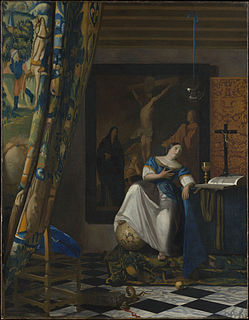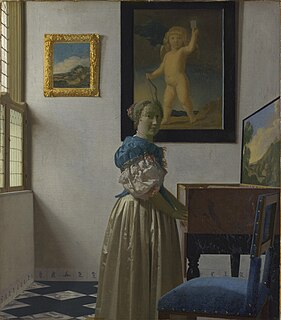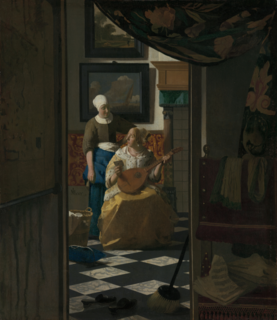 W
WThe following is a list of paintings by the Dutch Golden Age painter Johannes Vermeer. After two or three early history paintings, he concentrated almost entirely on genre works, typically interiors with one or two figures. His popularity is due less to his subject matter than to the poetic manner in which he portrays his subjects. Vermeer's paintings of the 1660s are generally more popular than his work from the 1670s: in the eyes of some, his later work is colder.
 W
WThe Allegory of Faith, also known as Allegory of the Catholic Faith, is a Dutch Golden Age painting by Johannes Vermeer of about 1670–1672. It has been in the Metropolitan Museum of Art in New York since 1931.
 W
WThe Art of Painting, also known as The Allegory of Painting, or Painter in his Studio, is a 17th-century oil on canvas painting by Dutch painter Johannes Vermeer. It is owned by the Austrian Republic and is on display in the Kunsthistorisches Museum in Vienna.
 W
WThe Astronomer is a painting finished in about 1668 by the Dutch Golden Age painter Johannes Vermeer. It is in oil on canvas, 51 cm × 45 cm, and is on display at the Louvre, in Paris, France.
 W
WChrist in the House of Martha and Mary is a painting finished in 1655 by the Dutch Golden Age painter Johannes Vermeer. It is now in the Scottish National Gallery in Edinburgh. It is the largest painting by Vermeer and one of the very few with an overt religious motive. The story of Christ visiting the household of the two sisters Mary and Martha goes back to the New Testament. The work has also been called Christ in the House of Mary and Martha.
 W
WThe Concert is a painting by the Dutch artist Johannes Vermeer depicting a man and two women performing music. It belonged to the Isabella Stewart Gardner Museum in Boston, but was stolen in 1990 and remains missing. Experts believe it may be the most valuable stolen object in the world; as of 2015, it was valued at US$250 million.
 W
WDiana and Her Companions is a painting by Dutch artist Johannes Vermeer completed in the early to mid-1650s, now at the Mauritshuis museum in The Hague. Although the exact year is unknown, the work may be the earliest painting of the artist still extant, with some art historians placing it before Christ in the House of Martha and Mary and some after.
 W
WThe Geographer is a painting created by Dutch artist Johannes Vermeer in 1668–1669, and is now in the collection of the Städelsches Kunstinstitut museum in Frankfurt, Germany. It is closely related to Vermeer's The Astronomer, for instance using the same model in the same dress, and has sometimes been considered a pendant painting to it. A 2017 study indicated that the canvas for the two works came from the same bolt of material.
 W
WA Girl Asleep, also known as A Woman Asleep, A Woman Asleep at Table, and A Maid Asleep, is a painting by the Dutch master Johannes Vermeer, 1657. It is now in the Metropolitan Museum of Art in New York City and may not be lent elsewhere under the terms of the donor's bequest.
 W
WGirl Interrupted at Her Music is a painting by the Dutch artist Johannes Vermeer. It was painted in the baroque style, probably between the years 1658 and 1659, using oil on canvas. Since 1901 it has been in the Frick Collection in New York City.
 W
WGirl Reading a Letter at an Open Window is an oil painting by Dutch Golden Age painter Johannes Vermeer. Completed in approximately 1657–59, the painting is on display at the Gemäldegalerie in Dresden. For many years, the attribution of the painting—which features a young Dutch woman reading a letter before an open window—was lost, with first Rembrandt and then Pieter de Hooch being credited for the work before it was properly identified in 1880. After World War II, the painting was briefly in possession of the Soviet Union. Apparently well-preserved, the painting may have been altered after the painter's death.
 W
WGirl with a Flute is a small painting attributed to the Dutch Golden Age painter Johannes Vermeer, executed 1665–1670. The work is in possession of the National Gallery of Art in Washington, D.C., just as Woman Holding a Balance, A Lady Writing a Letter and Girl with a Red Hat.
 W
WGirl with a Pearl Earring is an oil painting by Dutch Golden Age painter Johannes Vermeer, dated c. 1665. Going by various names over the centuries, it became known by its present title towards the end of the 20th century after the large pearl earring worn by the girl portrayed there. The work has been in the collection of the Mauritshuis in The Hague since 1902 and has been the subject of various literary treatments. In 2006, the Dutch public selected it as the most beautiful painting in the Netherlands.
 W
WGirl with a Red Hat is a rather small painting, signed by the Dutch painter Johannes Vermeer. It is seen as one of a number of Vermeer's tronies – depictions of models fancifully dressed that were not intended to be portraits of specific, identifiable subjects. Others believe it is a portrait. Whether Vermeer chose family members as models or found them elsewhere in Delft is irrelevant to the appreciation of his paintings. Its attribution to Vermeer – as it is on a (recycled) wood panel and not on canvas – has been a matter of controversy with scholars on both sides of the argument.
 W
WThe Girl with the Wine Glass is a 1659-1660 painting by Johannes Vermeer, now in the Herzog Anton Ulrich Museum in Braunschweig.
 W
WThe Guitar Player is an oil painting by Dutch Baroque artist Johannes Vermeer, dated c. 1672. This work of art is one of Vermeer's final artistic activities, providing insight into the techniques he mastered and approaches to painting he favored. The painting has been on display at Kenwood House, London since the 1920s, as part of the Iveagh Bequest collection. After being recovered from a theft in 1974, when the painting was held for ransom, The Guitar Player was returned to Kenwood House.
 W
WThe Lacemaker is a painting by the Dutch artist Johannes Vermeer (1632–1675), completed around 1669–1670 and held in the Louvre, Paris. The work shows a young woman dressed in a yellow shawl, holding up a pair of bobbins in her left hand as she carefully places a pin in the pillow on which she is making her bobbin lace. At 24.5 cm x 21 cm, the work is the smallest of Vermeer's paintings, but in many ways one of his most abstract and unusual. The canvas used was cut from the same bolt as that used for A Young Woman Seated at the Virginals, and both paintings seem to have had identical dimensions originally.
 W
WLady Seated at a Virginal, also known as Young Woman Seated at a Virginal, is a genre painting created by the Dutch Golden Age painter Johannes Vermeer in about 1670–1672 and now in the National Gallery, London.
 W
WLady Standing at a Virginal is a genre painting created by the Dutch artist Johannes Vermeer in about 1670–1672, now in the National Gallery, London.
 W
WLady Writing a Letter with her Maid (Dutch: Schrijvende vrouw met dienstbode) is a painting by the Dutch artist Johannes Vermeer, completed in 1670–1671 and held in the National Gallery of Ireland. The work shows a middle-class woman attended by a housemaid who is presumably acting as messenger and go-between for the lady and her lover. The work is seen as a bridge between the quiet restraint and self-containment of Vermeer's work of the 1660s and his relatively cooler work of the 1670s. It may have been partly inspired by Ter Borch's painting Woman Sealing a Letter. The painting's canvas was almost certainly cut from the same bolt used for Woman with a Lute.
 W
WA Lady Writing a Letter is an oil on canvas painting attributed to 17th century Dutch painter Johannes Vermeer. It is believed to have been completed by artist during his mature phase, in the mid-to-late 1660s. The work is in the collection of the National Gallery of Art in Washington, D.C..
 W
WThe Little Street is a painting by the Dutch painter Johannes Vermeer, executed c. 1657–58. It is exhibited at the Rijksmuseum of Amsterdam, and signed, below the window in the lower left-hand corner, "I V MEER".
 W
WThe Love Letter is a 17th-century genre painting by Jan Vermeer. The painting shows a servant maid commenting to her mistress on a letter the woman holds. The painting is in the Rijksmuseum Amsterdam.
 W
WThe Milkmaid, sometimes called The Kitchen Maid, is an oil-on-canvas painting of a "milkmaid", in fact, a domestic kitchen maid, by the Dutch artist Johannes Vermeer. It is now in the Rijksmuseum in Amsterdam, the Netherlands, which regards it as "unquestionably one of the museum's finest attractions".
 W
WMistress and Maid is an oil-on-canvas painting produced by Johannes Vermeer c. 1667. It portrays two women, a mistress and her maid, as they look over the mistress' love letter. The painting displays Vermeer's preference for yellow and blue, female models, and domestic scenes. It is now in the Frick Collection in New York City.
 W
WThe Music Lesson, Woman Seated at a Virginal or A Lady at the Virginals with a Gentleman by Johannes Vermeer is a painting of a young female pupil receiving a music lesson from a man. The man's mouth is slightly agape giving the impression that he is singing along with the music that the young girl is playing. This suggests that there is a relationship between the two figures and the idea of love and music being bridged together. This was a common theme among Netherlandish art in this time period. Vermeer consistently used the same objects within his paintings such as the draped rug, the white water jug, various instruments, tiled floor and windows that convey light and shadows. This is one of few paintings produced by Vermeer which were kept in his home until his death in 1675 when his family was forced to sell them. It became a part of the Royal Collection, and it is currently on display in the Picture Gallery at Buckingham Palace in London.
 W
WOfficer and Laughing Girl, also known as Officer and a Laughing Girl, Officer With a Laughing Girl or De Soldaat en het Lachende Meisje, was painted by the Dutch artist Johannes Vermeer between 1655 and 1660. It was painted in oil on canvas, typical of most Dutch artists of the time, and is 50.5 by 46 cm. It is now one of three pictures by Vermeer in The Frick Collection in New York
 W
WThe Procuress is a 1656 oil-on-canvas painting by the then 24-year-old Johannes Vermeer. It can be seen in the Gemäldegalerie Alte Meister in Dresden. It is his first genre painting and shows a scene of contemporary life, an image of mercenary love perhaps in a brothel. It differs from his earlier biblical and mythological scenes. It is one of only three paintings Vermeer signed and dated. In 1696 the painting, being sold on an auction in Amsterdam, was named "A merry company in a room".
 W
WSaint Praxedis is an oil painting attributed to Johannes Vermeer. This attribution has often been questioned. However, in 2014 the auction house Christie's announced the results of new investigations which in their opinion demonstrate conclusively that it is a Vermeer. The painting is a copy of a work by Felice Ficherelli, and depicts the early Roman martyr, Saint Praxedis or Praxedes. It may be Vermeer's earliest surviving work, dating from 1655.
 W
WStudy of a Young Woman is a painting by the Dutch artist Johannes Vermeer, completed between 1665 and 1667, and now in the Metropolitan Museum of Art, New York.
 W
WView of Delft is an oil painting by Johannes Vermeer, painted ca. 1659–1661. The painting of the Dutch artist's hometown is among his most popular, painted at a time when cityscapes were uncommon. It is one of three known paintings of Delft by Vermeer, along with The Little Street and the lost painting House Standing in Delft. The use of pointillism in the work suggests that it postdates The Little Street, and the absence of bells in the tower of the New Church dates it to 1660–1661. Vermeer's View of Delft has been held in the Dutch Royal Cabinet of Paintings at the Mauritshuis in The Hague since its establishment in 1822.
 W
WThe Wine Glass is a 1660 painting by Johannes Vermeer now in the Gemäldegalerie, Berlin. It portrays a seated woman and a standing man drinking in an interior setting. The work contains the conventions of genre painting of the Delft School developed by Pieter de Hooch in the late 1650s. It contains figures situated in a brightly lit and spacious interior, while its architectural space is highly defined. The figures are set in the middle ground, rather than positioned in the foreground.
 W
WWoman Holding a Balance, also called Woman Testing a Balance, is an oil painting by Dutch Golden Age painter Johannes Vermeer, now in the National Gallery of Art in Washington, DC.
 W
WWoman Reading a Letter is a painting by the Dutch Golden Age painter Johannes Vermeer, produced in around 1663. It has been part of the collection of the City of Amsterdam since the Van der Hoop bequest in 1854, and in the Rijksmuseum in Amsterdam since it opened in 1885, the first Vermeer it acquired.
 W
WWoman with a Lute, also known as Woman with a Lute Near a Window, is a painting created about 1662–1663 by Dutch painter Johannes Vermeer and now at the Metropolitan Museum of Art in New York.
 W
WWoman with a Pearl Necklace by Johannes Vermeer is a Dutch Golden Age painting of about 1664. Painted in oils on canvas, Johannes Vermeer portrayed a young Dutch woman, most likely of upper-class-descent, dressing herself with two yellow ribbons, pearl earrings, and a pearl necklace. As a very popular artist of the 17th century, the Dutch Golden Age, Vermeer depicted many women in similar circumstances within interior, domestic scenes. The same woman also appears in The Love Letter and A Lady Writing a Letter.
 W
WWoman with a Water Jug, also known as Young Woman with a Water Pitcher, is a painting finished between 1660–1662 by the Dutch painter Johannes Vermeer in the Baroque style. It is oil on canvas, 45.7cm x 40.6 cm, and is on display at the Metropolitan Museum of Art, New York.
 W
WA Young Woman Seated at the Virginals is a painting generally attributed to Johannes Vermeer, though this was for a long time widely questioned. A series of technical examinations from 1993 onwards confirmed the attribution. It is thought to date from c.1670 and is now in part of the Leiden Collection in New York. It should not be confused with Young Woman Seated at a Virginal in the National Gallery, London, also by Vermeer.